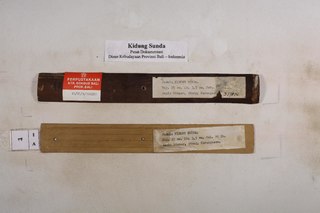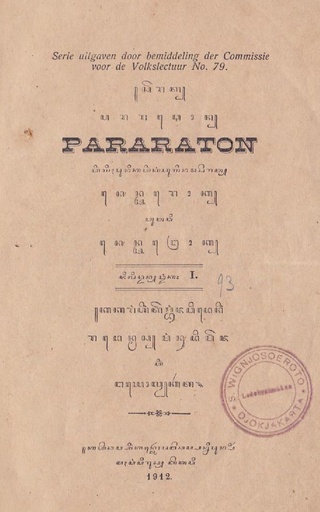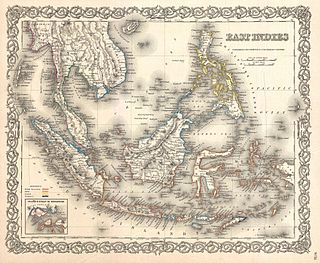
Majapahit, also known as Wilwatikta, was a Javanese Hindu-Buddhist thalassocratic empire in Southeast Asia that was based on the island of Java. It existed from 1293 to circa 1527 and reached its peak of glory during the era of Hayam Wuruk, whose reign from 1350 to 1389 was marked by conquests that extended throughout Southeast Asia. His achievement is also credited to his prime minister, Gajah Mada. According to the Nagarakretagama written in 1365, Majapahit was an empire of 98 tributaries, stretching from Sumatra to New Guinea; consisting of present-day Indonesia, Singapore, Malaysia, Brunei, southern Thailand, Timor Leste, southwestern Philippines although the scope of Majapahit sphere of influence is still the subject of debate among historians. The nature of Majapahit relations and influences upon its overseas vassals, and also its status as an empire are still provoking discussions.

Gajah Mada, also known as Jirnnodhara, was a powerful military leader and Mahapatih of the Javanese empire of Majapahit during the 14th century. He is credited in Old Javanese manuscripts, poems, and inscriptions with bringing the empire to its peak of glory.

Hayam Vuruk (1334–1389), also called Rajasanagara, Pa-ta-na-pa-na-wu, or Bhatara Prabhu after 1350, was a Javanese Hindu emperor from the Rajasa Dynasty and the 4th emperor of the Majapahit Empire. Together with his prime minister Gajah Mada, he reigned the empire at the time of its greatest power. During his reign, the Hindu epics, the Ramayana and the Mahabharata, became ingrained in the culture and worldview of the Javanese through the wayang kulit. He was preceded by Tribhuwana Wijayatunggadewi, and succeeded by his son-in-law Wikramawardhana.

Kidung Sunda is a Middle-Javanese kidung of probable Balinese provenance. In this poem, the story of king Hayam Wuruk of Majapahit who was looking for a bride to be, is narrated. At last he chose the princess of Sunda, a kingdom in West Java. The princess' name is remained undisclosed in this story, however she corresponds to Dyah Pitaloka Citraresmi in Pararaton. Hayam Wuruk's grand vizier Gajah Mada, betrayed his king and rejected this idea. There was a dispute about geopolitical relations between Sunda and Majapahit. Gajah Mada considered Sunda to be a vassal state of Java. For that reason a great battle took place in Bubat, the port where the Sundanese party landed as they refused to be treated as vassals. There the Majapahit-Javanese army slaughtered the Sundanese. The grieved princess of Sunda committed suicide not long afterwards. This historical story has to be situated somewhere in the 14th century.
Indonesian and Standard Malay are two standardised varieties of the Malay language, used officially in Indonesia on one hand and in Brunei, Malaysia and Singapore on the other. Both varieties are generally mutually intelligible, yet there are noticeable differences in spelling, grammar, pronunciation and vocabulary, as well as the predominant source of loanwords. The differences can range from those mutually unintelligible with one another, to those having a closer familial resemblance. The regionalised and localised varieties of Malay can become a catalyst for intercultural conflict, especially in higher education.

The Pararaton, also known as the Katuturanira Ken Angrok, is a Javanese historical chronicle written in Kawi. The comparatively short text of 32 folio-size pages contains the history of the kings of Singhasari and Majapahit in eastern Java.

Sri Maharajadiraja Sri Kertanegara Wikrama Dharmatunggadewa, Kritanagara, or Sivabuddha, was the last and most important ruler of the Singhasari kingdom of Java, reigning from 1268 to 1292. Under his rule Javanese trade and power developed considerably, reaching the far corners of the Indonesian archipelago.

Tribhuwana Wijayatunggadewi, known in her regnal name Tribhuwannottunggadewi Jayawishnuwardhani, also known as Dyah Gitarja, was a Javanese queen regnant and the third Majapahit monarch, reigning from 1328 to 1350. She also bears the title Bhre Kahuripan. With the help of her prime minister Gajah Mada, she pursued a massive expansion of the empire. Tradition mentioned her as a woman of extraordinary valour, wisdom and intelligence.
Dyah Pitaloka Citraresmi or Citra Rashmi (1340–1357), was the princess of the united Sunda Kingdom and Galuh Kingdom in Western Java. According to the Pararaton or Book of Kings, she was supposed to marry Hayam Wuruk, the new young king of Majapahit who had a great desire to take her as his queen. However, in the tragedy known as The Bubat Incident she took her own life. Tradition describes her as a young woman of extraordinary beauty.

Jayanegara or Jayanagara was a Javanese emperor and the second monarch of the Majapahit Empire from 1309 to his death in 1328, and also Prince of Kediri from 1295. Jayanegara was the heir, crown prince, and only son of Raden Wijaya, the founder of Majapahit. The story of his life was written in several records, including the Pararaton and Negarakertagama. His reign saw the beginning of Gajah Mada's rise to influence in the empire.
The Battle of Bubat also known as Pasunda Bubat is the battle between the Sundanese royal family and Majapahit army that took place in Bubat square on the northern part of Trowulan in 1279 Saka or 1357 CE.

Indonesia is the common and official name to refer to the Republic of Indonesia or Indonesian archipelago; however, other names, such as Nusantara and East Indies are also known. Some names are considered obsolete and confined to certain periods of history, while some might be more geographically specific or general.
The Regreg War was a civil war that took place in 1404–1406 within the Javanese empire of Majapahit. The conflict was fought as a war of independence between the Western court led by Wikramawardhana against the breakaway Eastern court led by Bhre Wirabhumi. This war of rivalry and secession had caused the calamity, crisis, court's preoccupation, the drain of financial resources, and exhaustion, that is thought to be one of the causes of Majapahit decline in the following years.

The Palapa oath was an oath taken by Gajah Mada, a 14th-century Prime Minister of the Javanese Majapahit Empire described in the Pararaton. In this oath Gajah Mada swore that he would not taste any spice, as long as he had not succeeded in unifying Nusantara. The oath was taken during his inauguration as Majapahit Amangkubhumi that took place in 1256 Saka (1334) or 1258 Saka (1336).

The Indonesian Malaysians are Malaysian citizens of Indonesian ancestry. Today, there are many Malaysian Malays who have lineage from the Indonesian archipelago and have played an important role in the history and contributed to the development of Malaysia, they have been assimilated with other Malay communities and are grouped as part of the foreign Malays or anak dagang in terms of race. The Malaysian census does not categorize ethnic groups from the Indonesian archipelago as a separate ethnic group, but rather as Bumiputera.

The Aru was a major Sumatran kingdom from the 13th to the 16th century. It was located on the eastern coast of North Sumatra, Indonesia. In its heyday the kingdom was a formidable maritime power, and was able to control the northern part of the Malacca strait.
Cetbang were cannons produced and used by the Majapahit Empire (1293–1527) and other kingdoms in the Indonesian archipelago. There are 2 main types of cetbang: the eastern-style cetbang which looks like a Chinese cannon and is loaded from the front, and the western-style cetbang which is shaped like a Turkish and Portuguese cannon, loaded from the back.
Adwayawarman was the father of King Adityawarman of Malayapura kingdom as mentioned in the Kuburajo I Inscription. His alias name was Adwayadwaja, as he was called in the Bukit Gombak Inscription.

Wawasan Nusantara or Indonesian Archipelagic Vision is the national vision of Indonesia towards their people, nation, and territory of the unitary state of the Republic of Indonesia; which includes its land, sea, also the air and space above it, as a unity of political, economic, social, cultural, defense and security entity. This national insight subsequently becomes the perspective or vision of the nation towards its national goals and ideals.

Bedil is a term from Maritime Southeast Asia which refers to various types of firearms and gunpowder weapons, from small pistols to large siege guns. The term bedil comes from wedil and wediluppu in the Tamil language. In their original form, these words refer to gunpowder blast and saltpeter, respectively. But after being absorbed into bedil in the Malay language, and in a number of other cultures in the archipelago, that Tamil vocabulary is used to refer to all types of weapons that use gunpowder. The terms bedil and bedhil are known in Javanese and Balinese, in Sundanese the term is bedil, in Batak it is known as bodil, in Makasarese, badili, in Buginese, balili, in Dayak language, badil, in Tagalog, baril, in Bisayan, bádil, in Bikol languages, badil, and in Malay it is badel or bedil.

















